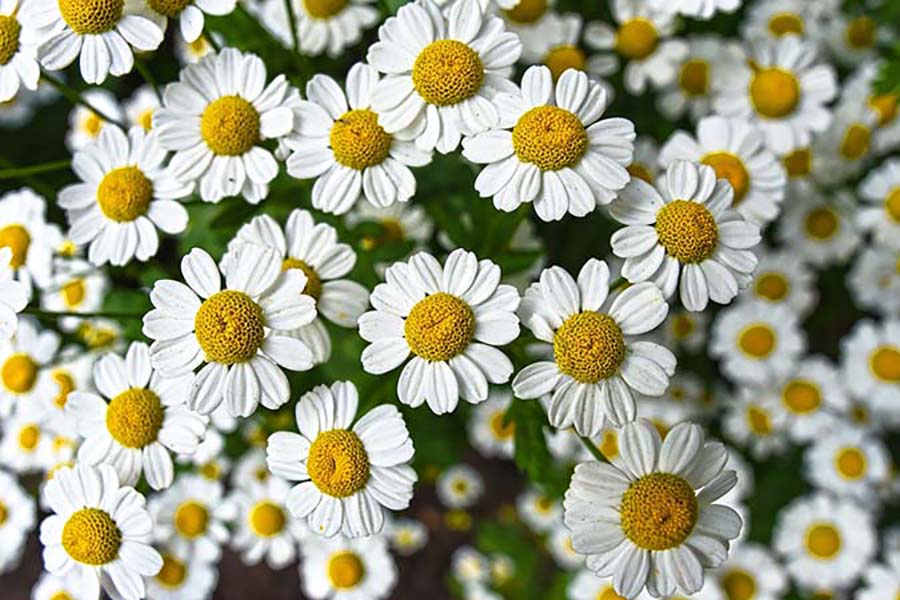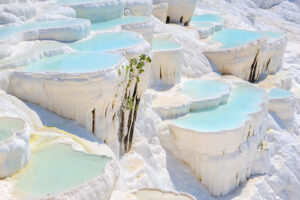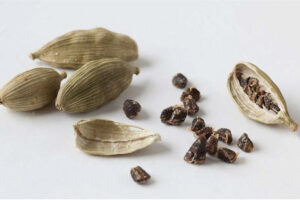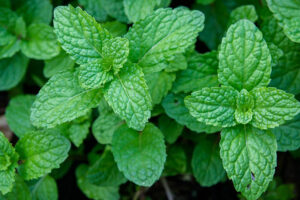In this in-depth profile on chamomile herb, you’ll learn the health benefits of chamomile, plus how to find and use this popular plant.
- Botanical Name: Matricaria recutita (syn. M. chamomilla)
- Family: Asteraceae
- Other Common Names: German chamomile, sweet false chamomile, wild chamomile, Hungarian chamomile, Italian chamomile, scented mayweed
- Parts Used: Flowering tops
- Energetics: Dry
- Thermal Properties: Warm
- Actions: Anti-cancer, anti-inflammatory, antibacterial, antifungal, antispasmodic, aromatic, bitter, carminative, mild sedative, relaxing diaphoretic, relaxing nervine, vulnerary
- Taste: Bitter, pungent
- Plant Uses: Teething, colic, women’s health, insomnia, anxiety, depression, digestive issues, muscle tension, fever, colds, flu, allergies, general aches and pains, and many others
- Plant Preparations: Tea, infused oil, tincture, essential oil, bath, steam, cough drops, lotions, food, flavoring, perfume
- Toxicities/Warnings: Chamomile is generally very safe and well tolerated, even over extended use. Occasionally, individuals may be allergic to chamomile, and should not consume it if they are. Cautions about using chamomile while pregnant are probably overstated. However, you should consult with a trained herbalist or medical professional before using it medicinally while pregnant. Chamomile is an effective and safe herb to use with young children.
Introduction to Chamomile
Before jumping into a conversation on chamomile, we had better make sure we’re all talking about the same plant.
Several beneficial plants bear the name “chamomile,” including Roman chamomile, German chamomile, Moroccan chamomile, and others. While each of these has their own benefits, we will be focusing on German chamomile (Matricaria recutita) in this article.
The common name “chamomile” comes from a word meaning “ground apple,” and refers to the apple-like aroma and low-growing habits of some chamomile species. Its genus, Matricaria, means “of-the-womb” and refers to its historical use in treating uterine infections. “Recutita” means “skinned” or “circumcised,” and is reference to the appearance of the flower head.
History of Chamomile
Chamomile was originally found in Western Europe and Northern Africa. But with its popularity and easygoing nature, it has now been spread to temperate areas all over the world.
As with many other excellent herbs, chamomile has a long history with humans. It has been used everywhere it has grown
Early American settlers brought chamomile with them from Europe. The Europeans were using chamomile centuries before that. And the Egyptians have used chamomile for thousands of years.
But our history with chamomile may extend much further back than that. Archeologists in Israel have discovered evidence that chamomile may have been used as long as 800,000 years ago.1)
Traditional Uses of Chamomile
Traditional uses of chamomile are so numerous that a complete listing would be impossible here.
Some of the main categories would include sleep aids, beauty products, women’s health, infection fighters, mood lifters, gentle medicines for pregnant women (see the Precautions and Contraindications section), treatment for any type of nervous system stress or disorder, treatment of digestive disorders, lowering fevers, treating various illnesses, aromatherapy and perfumes, and flavorings for food and drink.
Chamomile has not fallen out of favor in the modern world, either. The most popular use today is in chamomile tea.
However, it still finds mainstream use in food and drink flavorings, perfumes, and beauty products. And of course, its medicinal uses are still faithfully maintained by herbalists around the world.
Benefits of Chamomile
- Safe and Gentle: Chamomile is safe for children and infants, and it has a pleasant taste they’ll enjoy.2)
- Pain Reliever: Ease pains with chamomile, internally or topically.
- Digestive Health: Sip chamomile tea to ease nausea, indigestion, and gas. It can also help to soothe and heal ulcers.
- Allergy Relief: Chamomile reduces histamine formation, helping to reduce allergic reactions and excess mucous production.
- Muscle Cramps: Relax tired, cramping muscles with chamomile.
- Women’s Health: Chamomile is beneficial for a variety of women’s health issues, including menopause, uterine infections, the physical and emotional symptoms of PMS, and mastalgia.
- Skin Health: Use chamomile to maintain a youthful appearance, speed healing of injured skin, clear up skin infections, and smooth the complexion.
- Emotional Health: Chamomile has been shown to help relieve depression and anxiety, and to gently lift the mood of those who regularly drink it.
- Detoxify: Chamomile is a gentle detoxifier, especially for the liver.
- Antioxidant Source: Drink up a cup full of powerful antioxidants with chamomile tea.
- Antimicrobial: Chamomile fights bacteria on the skin, on the teeth, and in the body.
- Anti-Cancer: Chamomile has demonstrated anti-cancer properties, and protects against some negative effects of chemotherapy.
- Anti-Inflammatory: Chamomile can help to lower inflammation levels throughout the body.
- Gentle Sleep Aid: Use chamomile to help you drift off into peaceful sleep.
- Natural Fever Reducer: Chamomile helps your body to naturally lower a high temperature, rather than artificially forcing it lower, like a pharmaceutical.
- Congestion: Chamomile helps to break up respiratory system congestion. Breathe freely with chamomile.
- Dental Health: Use chamomile as a rinse and gargle to break up plaque and to stimulate healthy gums and teeth.
- Heart Health: Chamomile has been linked to lower blood pressure and instances of heart attack.
Medicinal Uses of Chamomile Herb
German chamomile is one of the most popular medicinal plants in the world. It has quite a number of medicinal uses; many more than we could hope to cover here. But we’ll cover as much as possible.
Sleep Aid
Chamomile’s most famous use is likely that of a gentle sleep aid. The most widely known method is with a simple cup of tea. But you could also smell the essential oils or relax in a hot herbal bath. All applications are equally valid.
Chamomile’s restful properties don’t work like a pharmaceutical drug. That is, they don’t force you to sleep. Rather, they help to relieve your physical and emotional tension, allowing you to drift off to sleep naturally.
While the direct effect of a pharmaceutical might have more raw power than a cup of tea, chamomile will help to relieve the source of your sleeplessness, not just suppress it.
Chamomile works through your whole self, helping to relieve physical, mental, and emotional tension. It helps to prevent and relieve muscle cramps, and relieve pain associated with tight muscles that are still holding onto the stress of the day.
It calms the nervous system and helps switch on the parasympathetic system, which controls resting and healing. When used as a sleep aid, more chamomile is often better. However, even small doses can have an effect.
Mood Lifter and Anxiety Soother
Beyond sleep, chamomile’s effects on the nervous system can help to lift the mood and calm overactive thoughts. Chamomile use has been shown to have a significant effect on depression and generalized anxiety disorder symptoms. There is also some limited evidence to support its use in the treatment of ADHD.
Digestive Health Support
Various digestive issues respond well to chamomile. It helps to calm overactive sensations and cramping in the bowels, as well as promote correct digestion, relieve constipation, prevent vomiting, and relieve gas pain. It can also help to soothe and heal ulcers. Chamomile is especially helpful when these symptoms are linked to stress. Ulcers respond especially favorably to its use. Chamomile reduces ulcer pain, speeds up their healing, and helps to prevent new ulcers from forming.
Natural Antihistamine
Allergy sufferers may also wish to reach for a cup of chamomile instead of over-the-counter antihistamines. Chamomile naturally reduces histamine production and reduces excess mucous production. It also helps to detoxify the liver, which lesson the body’s overreaction to environmental irritants and allergens.
Antibacterial and Antifungal
Chamomile has antibacterial and antifungal actions. Chamomile tea can be used as an eyewash to help clear conjunctivitis, or as a mouth rinse and gargle for tooth and gum health. Chamomile helps to lower fevers by supporting your body’s ability to sweat out toxins and invading microbes. Cold and flu sufferers can also find some relief in chamomile.
Pain Reliever
Chamomile can ease minor aches and pains throughout the body. This is partly a direct pain-relieving action of the plant, but also partly due to its ability to relieve the root causes of various pains. Anywhere inflammation or tension are present, chamomile can help bring relief.
PMS Symptom Reliever
Another big area for chamomile is women’s health. It is often taken to help with the physical and emotional symptoms of PMS, and was found to be superior to NSAIDs, with fewer side effects. It also helps with menopause symptoms. Mothers can use chamomile to stimulate milk production. Chamomile can also be used to alleviate postpartum depression and recurring mastalgia. Traditionally, chamomile tea has been given to pregnant mothers. However, you should read the Precautions and Contraindications section for more information on this.
Skin Healer
A number of skin conditions benefit from both internal and topical chamomile use. Chamomile helps to clear the complexion and preserve skin’s useful appearance. It can help to fight fungal and bacterial infections, and soothe rashes and other irritations. Wound healing is faster and stronger with chamomile, and chamomile can even help to fade old scars. Calendula and chamomile work well together in this area and are often combined for wound healing.
Cancer Fighter
Chamomile has anti-cancer properties for a variety of cancers, including thyroid, skin, prostate, breast, and ovarian. One study found that a long-term habit of drinking chamomile tea may reduce the risk of thyroid cancer by nearly 80%. Chamomile can also help to prevent and heal mouth sores associated with chemotherapy and radiation treatments. Here again, chamomile is often paired with calendula. Chamomile can also help to prevent vomiting associated with cancer treatment.
Child Friendly
And of course we can’t forget that chamomile is a classic herb for children, due to its pleasant taste and gentle nature. But don’t be fooled by the word “gentle.” “Gentle” doesn’t mean “weak.” It just means that it won’t rough you up when you take it.
Additional Uses
As stated before, chamomile has far too many uses to go into detail on them all. We’ve already gone over quite a few, but we still haven’t addressed its uses for heart health, diabetes, carpal tunnel syndrome, ear infections, alcohol toxicity, or chicken pox.
You can see how this could quickly turn into a book. Chamomile’s uses are so broad that the saying should be, “When in doubt, try chamomile.” Whatever your problem is, it’s got a great chance of helping, and almost couldn’t make anything worse.
Nutrition Properties
Chamomile flowers are rarely eaten directly, though they can be. They are much more often consumed as a tea.
In this form, chamomile is very low in calories, but still provides an easily absorbed solution of nutrients. These include calcium, iron, magnesium, manganese, niacin, phosphorus, potassium, riboflavin, vitamin A, and vitamin C. Chamomile tea is an excellent source of a variety of antioxidants.
If you’d like to try eating chamomile flowers, trying crushing a few blooms and browning them in butter or coconut oil. Then toss them in with your oatmeal to add an apple-like flavor.
How to Prepare and Use Chamomile
Infusion
A simple cup of chamomile tea is the most common, and one of the most enjoyable, ways to use this plant.
Place chamomile herb in a cup and pour boiling water over it. Depending on your goal, and your affinity for the herb, you may want to use anywhere from 1 tsp. to 2 tbsp. of dried chamomile.
Chamomile is very safe, and it’s fine to experiment with different amounts until you find what will work for you. Use a saucer to cover the cup and prevent its essential oil content from escaping.
When the tea has cooled enough to drink, tip the saucer to allow any condensed liquids to fall back into the cup. Drink it as often as desired.
Discover the shockingly simple way to get real nutrition that will deeply nourish your body. (Seriously, this method is so easy—and effective—you’ll wonder why you’ve never heard of it before!) Click here to learn more!
Tincture
Place dried chamomile in a mason jar and cover it with alcohol so that the herbs are covered by an inch or two. Because we are mainly focused on drawing out the essential oils, we will want a higher proof alcohol. Around 180 proof (90% alcohol) would be best, but a lower proof can be used.
(If you are trying to extract components other than the essential oils, you may wish to use around 40%-50% alcohol.)
Screw on the lid, shake it up, and label your jar. Place it in a cool, dark location, such as a pantry or kitchen cabinet. Come back to shake it up daily for about 4 weeks. At this point, you can strain out the herbs and rebottle your tincture. Alternately, leave it sitting for as long as desired.
Dosing recommendations for tinctures will vary, depending on your sources. This phenomenon is amplified by the widespread popularity of chamomile. Everyone makes their tincture a little differently, and everyone has their preferred way of using it.
Thankfully, chamomile is very safe, and this dosing flexibility is usually not an issue. One reasonable adult dose for this tincture would be 1-2 dropperfuls (about 1/4 to 1/2 tsp), 3 times a day.
Children would take half this, or less.
An herbalist may recommend a different dose for your specific circumstances.
Infused Oil
Place dried chamomile in a mason jar and cover it with oil so that the herbs are covered by an inch or two. Popular oil choices are coconut, olive, and jojoba. But others can also be used.
Screw on the lid, label your jar, and shake it up.
Now place it in a brown paper bag and set the jar in a sunny windowsill. The gentle warmth from the sunlight will help the herbs infuse into the oil, and the paper bag will help to soften the sunlight and protect the herbs from its more damaging effects.
After 3 weeks, strain out the herbs and rebottle the oil. Rub the oil on liberally, as often as desired. Infused oils are typically pretty shelf stable, but refrigeration will greatly extend their life. If the oil smells rancid or “off,” it’s time to toss it out.
Essential Oil
Many of chamomile’s medicinal properties come from its oil content. This makes chamomile essential oil an excellent strategy for herbal application.
Aromatic Use of Essential Oils
Essential oils evaporate very quickly, making them one of the best herbal application to administer by inhalation. This gives them direct access to the entire respiratory system. Being highly aromatic, they can also directly stimulate the limbic system via our sense of smell.79)
An essential oils diffuser is an excellent tool for conveniently inhaling oils. But oils can also be inhaled directly from the bottle, or by placing a drop onto a cotton ball and holding it under your nose.
Topical Use of Essential Oils
Not everyone is comfortable with direct skin application of essential oils. Some feel that it must be mixed with a carrier oil, such as coconut oil or jojoba oil.
Regardless of your thoughts on this, using a carrier oil will help to distribute the essential oil over a larger area
You need not worry about diluting its effectiveness. Essential oils are incredibly concentrated.
Drip one drop of chamomile essential oil into enough coconut (or other) oil to cover the desired area and stir it in. Then rub it over the skin and enjoy its benefits.
Internal Use of Essential Oils
Internal consumption of essential oils is controversial, and much too large of a topic to cover here.
If you feel comfortable ingesting essential oils, remember that they are very concentrated. A single drop is often enough to bring about the desired results. Some drip it into their mouth directly. Others dilute it with a drink.
Herbal Bath
Try a relaxing chamomile bath to wash away the stress of the day. Place dried chamomile into a cloth bag and tie it so that the water from your bath faucet flows through the bag.
Run straight hot water at first, to pull out the medicinal components, then adjust the temperature as needed. You should also close the bathroom door to keep any evaporated essential oils from escaping the room.
Relax in the tub, and allow your skin to soak in the goodness. You can also use the cloth bag of herbs like a bath scrub or wash cloth. Or close your eyes and lay it across your face to relax your eyes and facial muscles.
Herbal Steam
Chamomile works well as an herbal steam, due to its concentration of easily evaporating oils.
Boil a desired quantity of water. Remove it from heat and place chamomile into the water.
Hold the desired body part over the water, being careful not to burn yourself. Drape a large towel over everything. The idea is to make a tent to hold in the steam and evaporated herbal compounds, and to allow them to condense on the skin. You can also stick your head under the towel and breathe in the steam.
The quantities here are highly variable and will depend on the area you are treating. If you’re treating a finger, you may only need a cup of water and a tsp of chamomile. If you’re steaming your whole torso, you’ll need a lot more.
It’s okay to guess. If you feel that you didn’t use enough, just steam some more.
Chamomile for Pets
Chamomile can be safely used with your dog or cat. Use chamomile as a wound wash, itch reliever, or destressor, much as you would for a human. Chamomile is good for calming your pet down when he or she gets nervous or agitated.80)81)
When used internally, use a much smaller dosage than you would for a human. Cats may only need 1/2 tsp. of chamomile infusion.82)
Some animals may be allergic to chamomile. Expose a small area of skin to a chamomile preparation, and wait to see if your pet has a reaction.
Precautions and Contraindications
Chamomile herb is very safe for people of all ages. A small number of people may have allergic reactions to chamomile and should not use it. An allergy to ragweed or other plants in the Asteraceae family may increase your chances of being allergic to chamomile.
Pregnant women are warned not to use chamomile. However, this caution might be over-stated. Despite the frequent consumption of chamomile by women worldwide, no credible proven increase in rates of harmful outcomes for the fetus can be established.83) Many times, studies suggesting a link between chamomile and pregnancy risk will ignore the impact of other, more likely, herbs and drugs. Nevertheless, a lack of proof that chamomile is unsafe is not the same as proof that it is safe. Use caution and consult your doctor before consuming chamomile during pregnancy.
Chamomile is safe for breastfeeding mothers.84)
How to ID Chamomile Herb
Chamomile is a member of the Asteraceae family. It has small, daisy-like flowers with white petals and yellow, cone-shaped centers. The stems are thin, and the leaves are feathery and light.
German chamomile grows upright, to a height of around 1 or 2 feet (30-60 centimeters). Roman chamomile is physically very similar, but grows as a ground cover.
Chamomile may be superficially similar to many other daisy-like flowers. But in addition to its other features, chamomile can be distinguished by the apple-like scent of its blooms.
Always be sure of your identification before consuming a wild plant.
Where It Grows and Where to Find It
Chamomile can be found in temperate location around the world. You can most easily find chamomile growing in flower and herb gardens. It can also be found in the wild.
German chamomile likes open, sunny locations, but will tolerate light shade. It will also tolerate poor fertility, clay soils, and hot, dry weather.
German chamomile is an annual and can easily be grown from seed.
How and When to Harvest Chamomile
Harvest chamomile blooms when they are at their fullest, preferably before the white petals start to fall away. Harvesting encourages continued blooming. A regularly harvested plant can produce blooms all summer.
Blooms can be pinched off individually, or picked en masse by running your fingers through the plant like a comb. Special comb-like harvesting tools can also be purchased.
Use chamomile fresh or dry it with as little heat as possible. Store dried chamomile in an airtight container to preserve its essential oil content.
Many of chamomile’s healing properties come from its volatile oils (essential oils). Because these oils are easily lost to evaporation, processing and storage methods are important.
Chamomile is best when used fresh or dried at a low temperature and stored in an airtight container. A plastic zipper-lock bag is alright for temporary storage. However, the volatile oil molecules are so tiny that, over time, they can escape in the gaps between the molecules of the plastic bag. For long-term storage, use an airtight container, such as a mason jar with a tight-fitting lid.
Other applications, such as tinctures and distilled essential oils, can also keep your herbs potent for many years.
This story originally appeared at The Grow Network.







